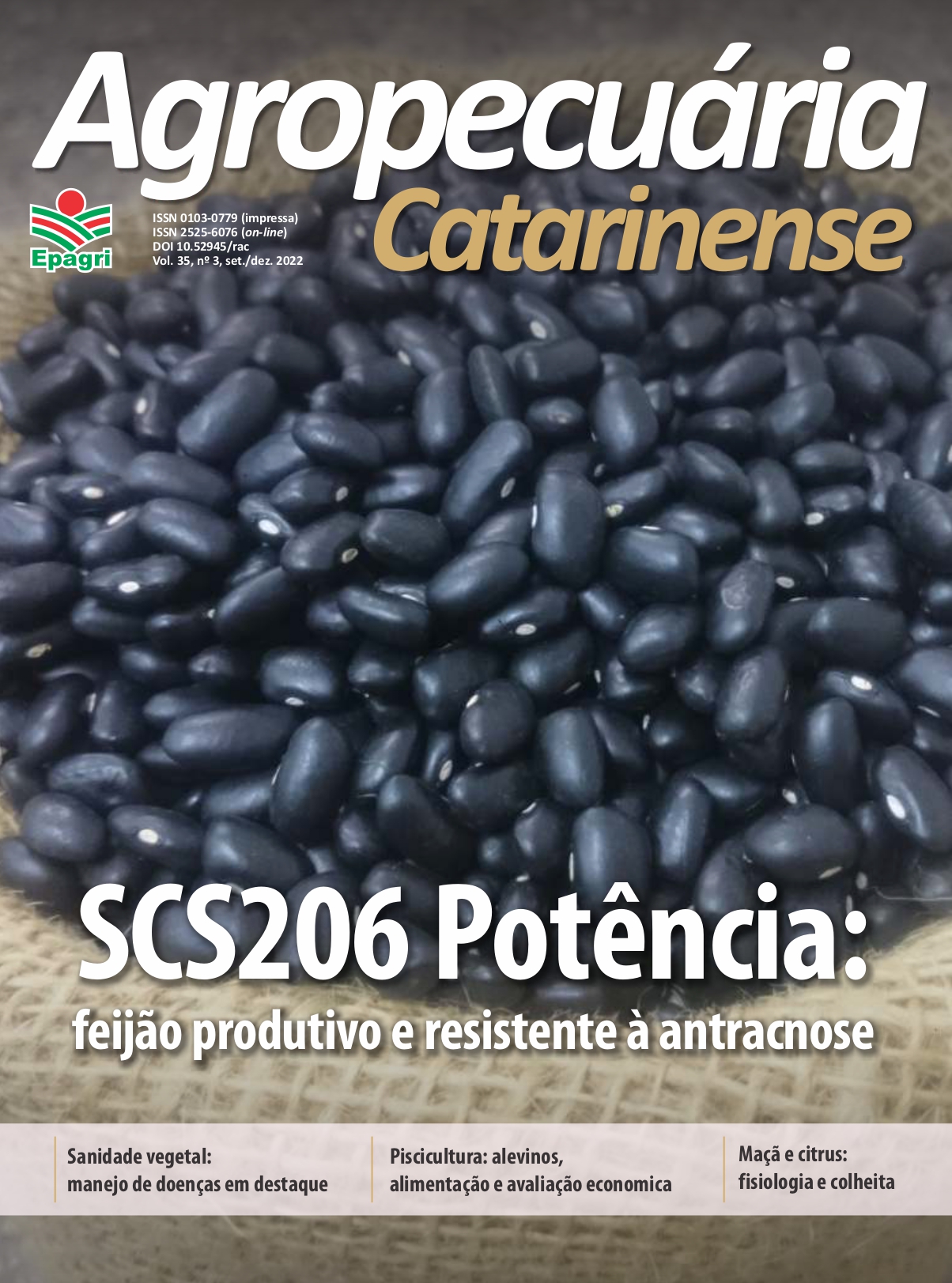Profile of beekeepers and aspects of stingless bee breeding in Santa Catarina
DOI:
https://doi.org/10.52945/rac.v35i3.1471Keywords:
Native bees, meliponiculture, meliponini, socioeconomic aspectsAbstract
Bees are responsible for pollinating 90% of flowering plants. In different Brazilian biomes it is estimated the occurrence of 300 species of stingless bees. Due to the ease of handling, meliponiculture has stood out as an economic and recreational activity in Santa Catarina. This study aimed to evaluate the socioeconomic aspects of beekeepers in Santa
Catarina state. The information was obtained through the application of an online questionnaire addressing topics related to the raising of stingless bees. Sixty-two responses were obtained from beekeepers from 31 municipalities distributed across the state. Meliponiculture is practiced by breeders between 26 and 45 years old who started the activity less than three years ago. Among those who answered the questionnaire, 75.8% live in urban areas, having the activity as a hobby. The most raised bee species is the jataí (Tetragonisca angustula). This is the first study on the profile of stingless beekeepers in Santa Catarina and identifying the demands and improvements that can be made in the sector.
Metrics
Publication Facts
Reviewer profiles N/A
Author statements
- Academic society
- Epagri - Revista Agropecuária Catarinense
- Publisher
- Empresa de Pesquisa Agropecuária e Extensão Rural de Santa Catarina - Epagri
References
AME-Joinville. Associação de meliponicultores de Joinville. Disponível em: https://ame-joinville.blogspot.com/p/pagina-inicial.html. Acesso em: 23 ago. 2021.
ALVES-JUNIOR, V. V.; CARBONARI, V.; CARBONARI, O.; ROSSINI, F, L. Seleção de rainhas: uma opção rentável aos apicultores de Mato Grosso do Sul. Revista Brasileira de Agroecologia, v.3, n.2, 2008.
BARROS, H.M. Manejo racional de colônias de Meliponíneos. Curso de Agronomia, Centro de Ciências Agrárias, Universidade Federal de Santa Catarina, Florianópolis, 2013.
BERGALLO, H.G.; UZÊDA, M.C.; FIDALGO, E.C.C.; ALVES, M.A.S.; ROCHA, C.F.D.; SLUYS, M.V.; COSTA, T.C.C.; COSTA, M.B.; SANTOS, M.A.; COZZOLINO, A.C.R.; ALENCAR, R.S. Conservação da Biodiversidade da Mata Atlântica no Estado do Rio de Janeiro: Uma nova abordagem. Rio de Janeiro: Instituto Biomas, 2009.
BILUCA, F.C. Caracterização química e bioativa de méis de abelhas sem ferrão (Meliponinae) produzidos no estado de Santa Catarina. 2018, 180p. Tese (Doutorado). Ciência dos Alimentos do Centro de Ciências Agrárias – Universidade Federal de Santa Catarina, Florianópolis – SC, 2018.
BLOCHTEIN, B.; FERREIRA, N.R.; TEIXEIRA, J.S.G.; FERREIRA JUNIOR, N.T.; WITTER, S. CASTRO, D. Manual de boas práticas para criação e manejo racional de abelhas sem ferrão no RS. EDIPUCRS: Porto Alegre, 2008. 48p.
CIDASC. Apicultor e meliponicultor, informe-se! 2020. Disponível em:http://www.cidasc.sc.gov.br/blog/2020/05/09/apicultor-e-meliponicultor-informe-se-2/. Acesso em: 24 ago. 2021.
CORTOPASSI-LAURINO M.; IMPERATRIZ-FONSECA, V.L.; ROUBIK, D.W.; DOLLIN, A.; HEARD, T.; AGUILAR, I.; VENTURIERI, G.C.; EARDLEY, C.; NOGUEIRA-NETO, P. Global meliponiculture: challenges and opportunities. Apidologie, v.37, p.275-292, 2006.
DANTAS, M.C.A.M.; BATISTA, J.L.; DANTAS, I.M.; DIAS, V.H.P.; ANDRADE FILHO, F.C. Abelha sem ferrão e seu potencial socioeconômico nos Estados da Paraíba e Rio Grande do Norte. Research, Society and Development, v.9, n.10, e3309107939, 2020. DOI: http://dx.doi.org/10.33448/rsd-v9i10.7939
EPAGRI. Mel de abelhas sem ferrão é regulamentado em Santa Catarina. 2020. Disponível em: https://www.epagri.sc.gov.br/index.php/2020/11/13/mel-de-abelhas-sem-ferrao-e-regulamentado-em-santa-catarina/#:~:text=A%20portaria%20SAR%20n%C2%BA%2037,produto%2C %20destinado%20ao%20consumo%20humano. Acesso em: 05 mar. 2021.
FERREIRA, M. N.; BALLESTER, W. C.; DORVAL, A.; COSTA, R. B. Conhecimento tradicional dos Kaiabi sobre abelhas sem ferrão no Parque Indígena do Xingu, Mato Grosso, Brasil. Tellus, Campo Grande, v.10, n.19, p.131-137, 2010. DOI: https://doi.org/10.20435/tellus.v0i19.212
GIANNINI, T. C.; BOFF, S.; CORDEIRO, G. D.; CARTOLANO JUNIOR, E. A.; VEIGA, A. K.; IMPERATRIZ-FONSECA, V. L.; SARAIVA, A. M. Crop pollinators in Brazil: a review of reported interactions. Apidologie, 2014. DOI: 10.1007/s13592-014-0316-z
HALL, D. M.; GERARDO, R. C.; TONIETTO, R. K.; OLLERTON, J.; AHRNÉ, K.; ARDUSER, M.; ASCHER, J. S.; BALDOCK, K. C. R.; FOWLER, R.; FRANKIE, G.; GOULSON, D.; GUNNARSSON, B.; HANLEY, M. E.; JACKSON, J. I.; LANGELOTTO, G.; LOWENSTEIN, D.; MINOR, E. S.; PHILPOTT, S. M.; POTTS, S. G.; SIHORI, M. H.; SPEVAK, E. M.; STONE, G. N.; THRELFALL, C. G. The city as a refuge for insect pollinators. Conservation Biology, v.31, n.1, p. 24-29, 2017.
JAFFÉ, R.; POPE, N.; MAIA, U. M.; IMPERATRIZ-FONSECA, V. L. Bees for Development: Brazilian Survey Reveals How to Optimize Stingless Beekeeping. Plos One, v.10, n.3, p. e0121157, 2015.
MENEZES, C. Meliponicultura: Aspectos Biológicos [recursos eletrônicos] / Menezes, Cristiano, coordenação de Patrícia Ortiz Monteiro; Coord. de Curso de Apicultura Meliponicultura Experimental de Prof.ª Dra. Lidia Maria Ruv Carelli Barreto -- Dados eletrônicos. – Taubaté. Ed. Unitau, 2020. 101p.
NOGUEIRA-NETO, P. Vida e criação de abelhas indígenas sem ferrão. São Paulo, Nogueirapis. 1997.
PEREIRA, F de M.; SOUZA, B. de A.; LOPES, M. T. do R. Criação de abelhas-sem-ferrão. Teresina: Embrapa Meio-Norte. 2017. 31p. Disponível em: http://www.infoteca.cnptia.embrapa.br/infoteca/handle/doc/1079116.
RAUBER, A.T. Meliponicultura e seus desafios: proposta de uma nova alternativa com sustentabilidade. 2011, 22p. Especialização (Captação de Recursos e Projetos de Investimentos) – Unoesc- SMO, 2011.
SILVA, W.P.; PAZ, J.R.L. Abelhas sem ferrão: muito mais do que uma importância econômica. Natureza online, p.146 – 152, 2012. Disponível em: http://www.naturezaonline.com.br/natureza/conteudo/pdf/09_Silva_Paz_146152.pdf. Acesso em: 23 mar. 2021.
SLAA, E. J.; CHAVES, L. A. S.; MALAGODI-BRAGA, K. S.; HOFSTEDE, F. E. Stingless bees in applied pollination: practice and perspectives. Apidologie, v.37, n.2, p.293-315, 2006.
STUCH, A.L.P.B. Estrutura de População em Abelhas Jataí (Tetragonisca angustula Letreille) por meio de Isoenzimas. 2006. 48p. Dissertação (Mestrado em Zootecnia) – Centro de Ciências Agrárias, Universidade Estadual de Maringá. Maringá, PR, 2006.
TEW, N. E.; MEMMOTT, J.; VAUGHAN, I. P.; BIRD, S.; STONE, G. N.; POTTS, S. G.; BALDOCK, K. C. R. Quantifying nectar production by flowering plants in urban and rural landscapes. Journal of Ecology, 2021. DOI https://doi.org/10.1111/1365-2745.13598
VILLAS-BÔAS, J. Mel de abelhas sem ferrão, Manual Tecnológico Mel de Abelhas sem Ferrão. 1ª edição. Brasília, DF. Instituto Sociedade, População e Natureza (ISPN), Brasil, 2012.
Downloads
Published
How to Cite
Issue
Section
License
Copyright (c) 2022 Bruna Gomes, Márcia Faita, Alex Poltronieri, André Sezerino

This work is licensed under a Creative Commons Attribution 4.0 International License.





